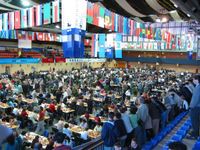
Photo from wikipedia
Background Our previous reports reflected some aspects of neuroplastic changes from long-term Chinese chess training but were mainly based on large-scale intrinsic connectivity. In contrast to functional connectivity among remote… Click to show full abstract
Background Our previous reports reflected some aspects of neuroplastic changes from long-term Chinese chess training but were mainly based on large-scale intrinsic connectivity. In contrast to functional connectivity among remote brain areas, synchronization of local intrinsic activity demonstrates functional connectivity among regional areas. Until now, local connectivity changes in professional Chinese chess players (PCCPs) have been reported only at specific hubs; whole-brain-based local connectivity and its relation to training profiles has not been revealed. Objectives To investigate whole-brain local connectivity changes and their relation to training profiles in PCCPs. Methods Regional homogeneity (ReHo) analysis of rs-fMRI data from 22 PCCPs versus 21 novices was performed to determine local connectivity changes and their relation to training profiles. Results Compared to novices, PCCPs showed increased regional spontaneous activity in the posterior lobe of the left cerebellum, the left temporal pole, the right amygdala, and the brainstem but decreased ReHo in the right precentral gyrus. From a whole-brain perspective, local activity in areas such as the posterior lobe of the right cerebellum and the caudate correlated with training profiles. Conclusion Regional homogeneity changes in PCCPs were consistent with the classical view of automaticity in motor control and learning. Related areas in the pattern indicated an enhanced capacity for emotion regulation, supporting cool and focused attention during gameplay. The possible participation of the basal ganglia-cerebellar-cerebral networks, as suggested by these correlation results, expands our present knowledge of the neural substrates of professional chess players. Meanwhile, ReHo change occurred in an area responsible for the pronunciation and reading of Chinese characters. Additionally, professional Chinese chess training was associated with change in a region that is affected by Alzheimer’s disease (AD).
Journal Title: Frontiers in Neuroscience
Year Published: 2022
Link to full text (if available)
Share on Social Media: Sign Up to like & get
recommendations!